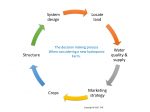Advantages and disadvantages of hydroponics
There are many advantages and disadvantages of hydroponics and field grown farming systems. It is however important that the system chosen should provide the highest income and is capable to supply the market with its requirements. A good starting point to learn more about hydroponics at The Science of Hydroponics – Introduction to Hydroponics
by Sue and Harley Smith. It’s an eBook, so you can quickly get started by reading it either on your computer or Kindle. A comparison of some of the advantages and disadvantages between conventional agriculture and hydroponics are provided below:
Just remember, hydroponics is not for everyone. It is high tech and a lot of things can go wrong. You don’t have the buffer that soil provides when something goes wrong with your irrigation system or fertilizer application equipment.
Don’t confuse the fact that hydroponically grown crops are mostly grown under greenhouses and that you cannot do that in soil culture. As a matter of fact, there are more and more growers using the safety of greenhouses with soil culture than before.
You can always install a hydroponic system later inside the greenhouse in order to improve your cash flow.
| Category | Hydroponics | Soil |
|---|---|---|
| Sterilization of growth medium | Chemical fumigants, short time needed. Growth medium is already sterilized by the supplier. | Steam, chemical fumigants, labour intensive, it takes time and is a lengthy process, minimum of 2 – 3 weeks. |
| Plant nutrition | Completely controlled, relatively stable, homogenous to all plants, readily available in sufficient quantities. Good control over pH. Easily adjusted, sampled and tested. | Highly variable, localized deficiencies, difficult to adjust due to high buffering capacity of soil, soil tests take long. |
| Plant spacing | Limited only by available light, therefore closer spacing is possible; increased number of plants per unit area, therefore more efficient use of space which results in greater yields per unit area. | Limited by soil nutrition and available light. |
| Weed control | No weeds, no cultivation except around the tunnels. | Weeds are present, cultivate regularly. |
| Disease control | No diseases, insects, animals in medium: no need for crop rotation. | Many soil borne diseases, nematodes, insects and animals that can attack the crop, often use crop rotation to overcome build-up of infestation. |
| Fruit quality | Fruit is firm with long shelf life. Longer shelf life helps with marketing of produce and results in less spoilage. | Fruit is often soft or puffy due to potassium and calcium deficiencies. This results in poor shelf life. |
| Fertilizers | Use small quantities, uniformly distributed to all plants, no leaching beyond root zone, efficient use. | Broadcast large quantities over the soil, non-uniform distribution to plants, large amounts are leached past root zone. |
| Sanitation | Good sanitation control in tunnels. | No sanitation possible on open land. |
| Transplanting | No preparation of medium required prior to transplanting. Shock minimized, initial transplant shock is less and adaption faster so subsequent growth processes get a head start. | Need to prepare soil, uprooted plants which lead to transplanting shock. Difficult to control soil temperatures, disease organisms that may adversely affect or even kill transplants. |
| Plant maturity | Plants in general mature faster and more even. | Due to high variation in microclimate in soil conditions, plants will mature at different times within a single season. |
| Yields | • Hydroponics: Up to 100 % higher in certain conditions. Expect at least 30 % higher first grade product yields. | Yields are unpredictable and quality varies considerably. |



